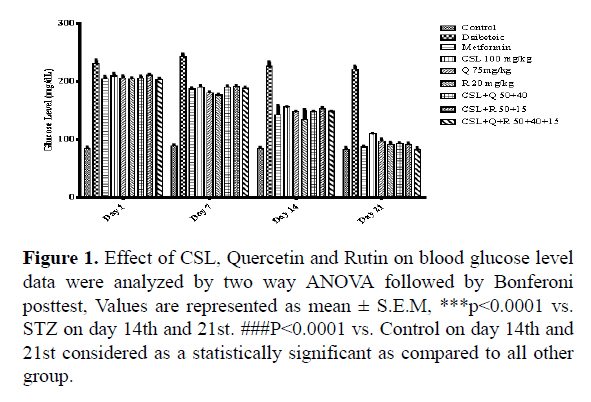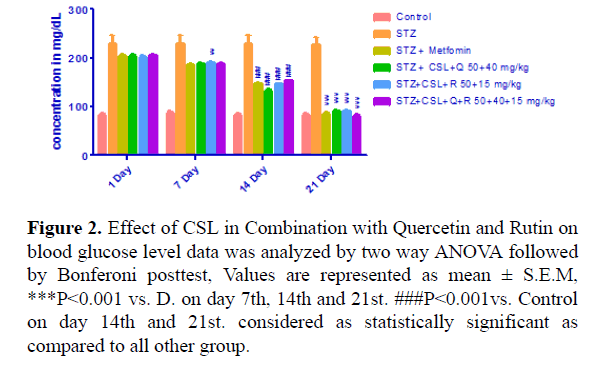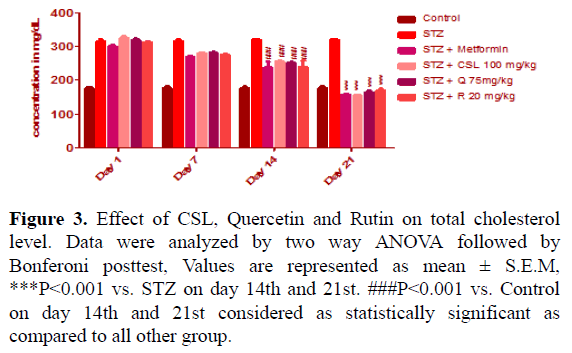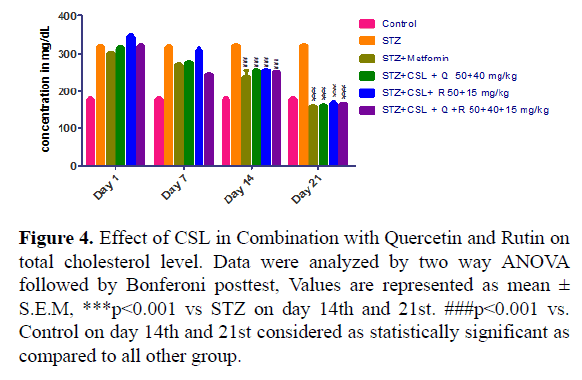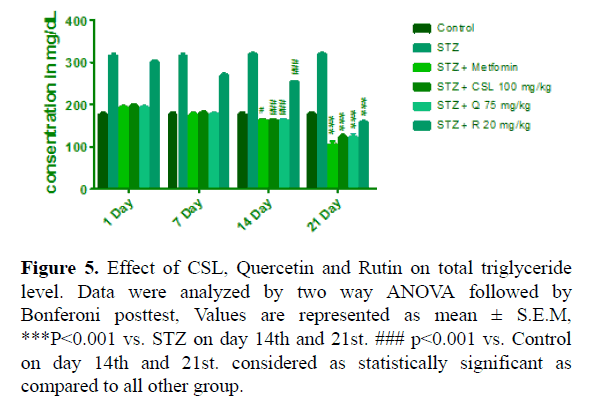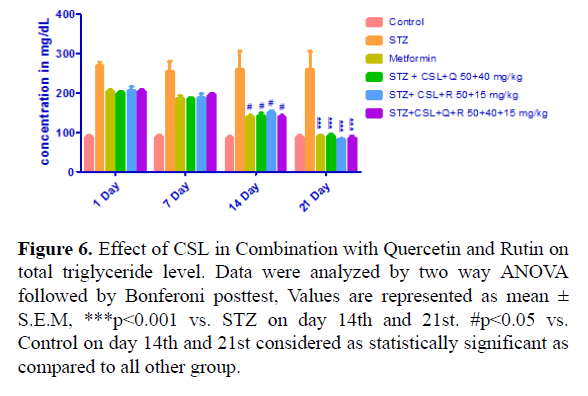Research Article - Asian Journal of Biomedical and Pharmaceutical Sciences (2019) Volume 9, Issue 67
Preventive effects of soy lecithin in combination with flavonoids on stz induced Diabetes Mellitus in rats
Zade KV*, Gulkari VD
Priyadarshine J. L College of Pharmacy, Nagpur, India
- Corresponding Author:
- Zade KV
Priyadarshine J L College of Pharmacy Nagpur India
E-mail: kanchanzade.7@gmail.com
Accepted date: June 17, 2019
Citation: Zade KV et.al. Preventive effects of soy lecithin in combination with flavonoids on stz induced Diabetes Mellitus in rats. Asian J Biomed Pharmaceut Sci. 2019;9(67):24-30.
DOI: 10.35841/2249-622X.67.19-253
Visit for more related articles at Asian Journal of Biomedical and Pharmaceutical SciencesAbstract
The present research work was design to investigate the anti-diabetic effect of Crude Soy lecithin (CSL) in combination with Flavonoids. Various dosed of CSL, quercetin and rutin were standardized and effective dose of CSL, quercetin and rutin was selected. Male Sprague Dawley rats weighing (200-225 g) were subjected to overnight fasting to induced diabetics by STZ (60 mg/kg i.p.) and blood sample was collected after 72 hrs to conform diabetics. Rats with blood glucose level ≥ 200 mg/dl were selected for further study. A dose of combination of CSL and quercetin with rutin p.o. was administered 60 min prior to blood sample withdrawal for estimation of glucose level. Positive control group were treated with STZ injected rats and negative control with metformin (100 mg/kg bw). Effect of CSL in combination with Flavonoids on Blood glucose level, Total Cholesterol level and Total Triglyceride level was evaluated. The results suggested treatment with CSL, quercetin and rutin were significantly decrease plasma glucose, cholesterol and triglyceride level in rats as compared to STZDiabetic rats. CSL show anti-diabetic effect alone and in combination with Flavonoids on STZ Induced Diabetes Mellitus (DM) in Rats.
Keywords
Crude soy lecithin, Flavonoids, Diabetic and STZ.
Introduction
Diabetes is a complex group of diseases with a variety of causes. Diabetes is a disorder of metabolism the way the body uses digested food for energy. With the help of the hormone insulin, cells throughout the body absorb glucose and use it for energy. Diabetes develops when the body doesn ’ t make enough insulin or is not able to use insulin effectively, or both [1]. World Health Organization (WHO) indicates that DM is one of the major killers of humans in our time and affects 1– 5% of the world population [2,3]. By the year 2025, the number of individuals with diabetes is predicted to be more than 325 millionin spite of availability of new drugs, techniques and surgical intervention [4,5].There are two types of DM. Type 1 (insulin-dependent) that results from damage of pancreatic insulin producing cells and type 2 (non-insulin-dependent) that results from insulin resistance [6]. Among various factors that are being involved in the progression of DM, oxidative stress playsimportant role in etiology of DM and related complications [7]. Persistent hyperglycemia is responsible for increasing formation of free radicals, autooxidation of glucose and lipid peroxidation as well as disturbance of the antioxidant defense system. The resultant free radicals bring about intracellular oxidative stress [8].
Flavonoids in experimental DM may be related to their antioxidative/chelatory properties. Increased glycosuria indicated that inhibition of renal glucose reabsorption may also play a role in the hypoglycaemic effect of both Flavonoids [9].
Lecithin composed of phosphatidylcholine (PC), phosphatidyl inositol (PI), phosphatidyl ethanolamine (PE), Phosphatidylserin (PS) and phosphatidic acid (PA) [10]. Lecithin is one of the components of bile that helps protect against gallstone formation. PC may help dissolve gallstones [11].
Aldose reductase, the enzyme that catalyzes the conversion of glucose to sorbitol, is especially important in the eye and plays an essential role in the formation of diabetic cataracts. Quercetin is an in vitro inhibitor of lens aldose reductase [12,13] and effectively blocks polyol accumulation in intact rat lenses incubated in medium containing high concentration of sugars [14].
Some studies report Rutin prooxidant activity and the ability to generate Reactive oxygen species (ROS), ascribed to aglycon quercetin [15-18]. Rutin reversed or prevented metabolic changes such as abdominal fat pads and glucose tolerance, reversed or prevented changes in hepatic and cardiovascular structure and function, reversed oxidative stress and inflammation in the liver and heart, and normalized expression of liver markers. These results suggest a non-nutritive role for rutin to attenuate chronic changes in metabolic syndrome [19].
Based on these, we demonstrated in the current study the possible protective effect of different doses of CSL in Combination with Flavonoids on STZ induced DM in Rats and correlated these effects with plasma glucose and insulin levels.
Materials and Methods
Chemicals
CSL were obtained from Perfect industries Pvt. Ltd., K-34, MIDC Five Star Indl, Area, Butibori, Nagpur, MS, India. as a free gift sample.
STZ were freshly dissolved in 5 mol/l citrate buffer, pH 4.5 and given intraperitonium (single injection, 60 mg/kg) [20]. CSL, Quercetin and Rutin were dissolved in 10 ml physiological saline (10 mg/ml) and given orally by gastric tube for 21 days. The doses were adjusted on the basis of a dose rang finding study.
Animals
Male Sprague Dawley rats with weighing 200-225 g each, at the beginning of experiment were use in the current study. The animals were feed on a standard laboratory food and water ad libitum under strict hygienic conditions and acclimatized for 1 week prier initiation of study. They were kept under standard laboratory conditions maintained at 25 ± 2°C, relative humidity at 50-70% under 12-h light: 12-h dark cycle. All animal experiments received approval from the ethical committee of Rashtrasant Tukdoji Maharaj Nagpur University, Nagpur, in strict compliance with ethical principles and guidelines of the Committee For The Purpose Of Control and Supervision of Experimental Animals (CPCSEA), Ministry Of Environment And Forests, Government of India, New Delhi.
Induction and treatment of diabetes
Diabetes were induced by a single injection with freshly prepared STZ 60 mg/kg b.w. dissolved in ice-cold 0.1 M citrate buffer (pH 4.5) through the tail vein of 12 h fasted rats. Blood sample were collected after 72 hrs of diabetics conformation. Rats with blood glucose level ≥ 200 mg/dl were selected for further study. A dose of combination of CSL and quercetin with rutin p.o. was administered 60 min prior to blood sample withdrawal for estimation of glucose level. Control group were treated with saline/STZ injected rats.
Experimental design
For experimental protocol dose of CSL and Rutin was standardized. Various dosed of CSL, quercetin and rutin were given and effective dose of CSL, quercetin and rutin was selected. Animals were randomly divided into 9 groups of six animals each.
Dose dependent study: To study the influence of CSL in Diabetic induced rat, different group were treated with saline (10 ml/kg, p.o) or CSL at various doses (40, 50 and 100 mg/kg p.o resp.) for the period of 21 days.
Doses standardization study: After the confirmation of Diabetes, animals were divided into 8 groups.
• The 1st group were receive vehicle for CSL, Quercetin and Rutin.
• The 2nd group were receive Metformin only in dose of 100 mg/kg as a Standard.
• The 3rd group were receive Streptozotocin only in dose of 60 mg/kg as a Diabetic control for a period of 3 days.
• The 4th, 5th and 6th group were receive CSL only in dose of 40, 50 and 100 mg/kg once daily for a period of 21 day.
• The 7th, 8th and 9th groups were receive Quercetin only in a dose of 40, 75 and 100 mg/kg once daily for a period of 21 day.
• The 10th, 11th and 12th groups were receive Rutin only in a dose of 15, 20 and 40 mg/kg once daily for a period of 21 day.
For experimental protocol dose of CSL, quercetin and rutin was standardized. Various dosed of CSL, Quercetin and Rutin were given and effective dose of CSL, quercetin and rutin was selected. Animals were randomly divided into 12 groups of six animals each.
Combination study: 1st group were receive vehicle for CSL, Quercetin, and Rutin i.e. saline.
2nd group were receive Metformin only in dose of 100 mg/kg as a Standard.
3rd group were receive STZ only in dose of 60 mg/kg as a Diabetic control for a period of 3 days.
4th group were receive CSL only in dose of 40 mg/kg.
5th group were receive Quercetin only in a dose of 40 mg/kg.
6th group were receive Rutin only in a dose of 15 mg/kg.
7th group were receive combination of CSL and Quercetin only in a dose of 40+40mg/kg respectively.
8th group were receive combination of CSL and Rutin only in a dose of 40+15 mg/kg respectively.
9th group were receive combination of CSL and Quercetin with Rutin only in a dose of 40+40+15 mg/kg respectively.
Biochemical evaluation: On 22nd day (25th day of STZ injection) animals were subjected to overnight fasting, 1 hr after the treatment blood sample were collect from rat tail vein on 0, 7th, 14th and 21st day and centrifuge at 2500 rpm for the separation of plasma. The plasma was used for the estimation of glucose, triglyceride and cholesterol by commercial kits.
Statistical analysis
The data are presented as mean ± S.E.M. Statistical comparisons were made by one-way analysis of variance (ANOVA) and followed by Bonferroni as the post hoc test (version 5). Data were considered significant when p values were lower than 0.05.
Results
Blood glucose level in single dose of CSL, Quercetin and Rutin
The effects of CSL, quercetin and rutin on blood glucose levels of control and STZ treated animals are summarized in Figure 1 and Table 1.
Figure 1: Effect of CSL, Quercetin and Rutin on blood glucose level data were analyzed by two way ANOVA followed by Bonferoni posttest, Values are represented as mean ± S.E.M, ***p<0.0001 vs. STZ on day 14th and 21st. ###P?0.0001 vs. Control on day 14th and 21st considered as a statistically significant as compared to all other group.
CSL at 100 mg/kg, Quercetin at 75 mg/kg and Rutin at 20 mg/kg shows significant (P?0.0001) decreased in blood glucose level as compared to control on day 14th and 21st and diabetic groups on day 14th and 21st. There was significant (p?0.0001) increase in blood glucose level of STZ injected rats as compared to control, CSL, Quercetin and Rutin groups.
Blood glucose level of CSL in Combination with Quercetin and Rutin: The effects of CSL in combination with quercetin with rutin on blood glucose levels of control morad.roudbaraki@univ-lille.frand STZ treated animals are summarized in Graph 2 and Table 1.
| Groups (mg/kg bw) | Blood glucose | |||
|---|---|---|---|---|
| 1st day | 7th day | 14th day | 21st day | |
| Control | 84 ± 2.6 | 88 ± 2.67 | 84 ± 1.96 | 83 ± 40 |
| Diabetic | 230 ± 6.75 | 242 ± 4.45 | 225 ± 8.68 | 220 ± 6.47 |
| Metformin | 204 ± 4.12 | 186.1 ± 2.18 | 141.8 ± 3.55### | 84.8 ± 5.79*** |
| STZ+CSL 100 | 208.8 ± 4.67 | 190.1 ± 2.76 | 155.6 ± 2.30### | 109.6 ± 4.33*** |
| STZ+Q 75 | 205.5 ± 4.60 | 179.5 ± 2.56 | 147.3 ± 1.60### | 96.5 ± 3.87*** |
| STZ+R 20 | 203 ± 2.51 | 176.3 ± 1.52 | 133.6 ± 2.47### | 90.5 ± 5.03 |
| STZ+CSL+Q 50+40 | 205 ± 3.82 | 189.8 ± 2.30 | 148 ± 0.96### | 92.33 ± 2.37*** |
| STZ+CSL+R 50+15 | 210 ± 2.45 | 190.8 ± 1.51 | 153.3 ± 1.28### | 91.66 ± 2.27*** |
| STZ+CSL+Q+R 50+40+15 | 202.8 ± 2.54 | 187.8 ± 2.38 | 148.1 ± 0.94### | 81.83 ± 33.40*** |
Note: S.E.M. standard error mean, number of animals in each group=6, *** P ? Control and *** P<0.001 v/s STZ
Table 1. Comparative effect of CSL, quercetin and rutin alone and, CSL in combination with quercetin and rutin on Blood glucose level.
There were significant (p?0.0001) increase in blood glucose level in STZ injected rats as compared to control, CSL in Combination with Quercetin, CSL in Combination with Rutin and CSL in Combination with Quercetin and Rutin groups. CSL at 50 mg/kg, Quercetin at 40 mg/kg and Rutin at 15 mg/kg in combination shows significant (p?0.0001) decreased in blood glucose level as compared to control on day 14th and 21st and diabetic groups on day 7th and 14th (Figure 2).
Figure 2: Effect of CSL in Combination with Quercetin and Rutin on blood glucose level data was analyzed by two way ANOVA followed by Bonferoni posttest, Values are represented as mean ± S.E.M, ***P<0.001 vs. D. on day 7th, 14th and 21st. ###P?0.001vs. Control on day 14th and 21st. considered as statistically significant as compared to all other group.
Total Cholesterol level in single dose of CSL, Quercetin and Rutin: CSL at 100 mg/kg, quercetin at 75 mg/kg and rutin at 20 mg/kg shows significant (p?0.0001) decreased in total cholesterol level as compared to control and diabetic groups. There was significant (p?0.0001) increase in Total Cholesterol level in STZ injected rats as compared to control, CSL, quercetin and rutin groups (Figure 3).
Figure 3: Effect of CSL, Quercetin and Rutin on total cholesterol level. Data were analyzed by two way ANOVA followed by Bonferoni posttest, Values are represented as mean ± S.E.M, ***P<0.001 vs. STZ on day 14th and 21st. ###P?0.001 vs. Control on day 14th and 21st considered as statistically significant as compared to all other group.
Total Cholesterol level of CSL in Combination with Quercetin and Rutin: CSL at 50 mg/kg, quercetin at 40 mg/kg and rutin at 15 mg/kg in combination shows significant (p? 0.0001) decreased in Total cholesterol level of control on day 14th and 21st and diabetic groups on day 14th and 21st. There were significant (p?0.0001) increase in blood glucose level in STZ injected rats as compared to control, CSL in Combination with quercetin, CSL in Combination with rutin and CSL in Combination with quercetin and rutin groups (Figure 4).
Figure 4: Effect of CSL in Combination with Quercetin and Rutin on total cholesterol level. Data were analyzed by two way ANOVA followed by Bonferoni posttest, Values are represented as mean ± S.E.M, ***p<0.001 vs STZ on day 14th and 21st. ###p?0.001 vs. Control on day 14th and 21st considered as statistically significant as compared to all other group.
Total Triglyceride level in single dose of CSL, Quercetin and Rutin: There were significant (p?0.0001) increase in blood glucose level in STZ injected rats as compared to control, CSL, quercetin and rutin groups. CSL at 100 mg/kg, quercetin at 75 mg/kg and rutin at 20 mg/kg shows significant (p?0.0001) decreased in Total triglyceride level of control on day 14th and 21st and diabetic groups on day 14th and 21st (Figure 5).
Figure 5: Effect of CSL, Quercetin and Rutin on total triglyceride level. Data were analyzed by two way ANOVA followed by Bonferoni posttest, Values are represented as mean ± S.E.M, ***P<0.001 vs. STZ on day 14th and 21st. ### p?0.001 vs. Control on day 14th and 21st. considered as statistically significant as compared to all other group.
Total Triglyceride level of CSL in Combination with Quercetin and Rutin: There were significant (P?0.0001) increase in blood glucose level of STZ injected rats as compared to control, CSL in Combination with quercetin, CSL in Combination with rutin and CSL in Combination with quercetin and rutin groups. CSL at 50 mg/kg, quercetin at 40 mg/kg and rutin at 15 mg/kg in combination shows significant (p?0.0001) decreased in Total Triglyceride level of control on day 14th and 21st and diabetic groups on day 14th and 21st (Figure 6).
Figure 6: Effect of CSL in Combination with Quercetin and Rutin on total triglyceride level. Data were analyzed by two way ANOVA followed by Bonferoni posttest, Values are represented as mean ± S.E.M, ***p<0.001 vs. STZ on day 14th and 21st. #p?0.05 vs. Control on day 14th and 21st considered as statistically significant as compared to all other group.
Discussion
Increasing evidence from both experimental and clinical studies suggests that oxidative stress plays a major role in the pathogenesis of DM. Free radicals are formed disproportionately in memory by oxidation and in diabetes by glucose oxidation, non-enzymatic glycation of proteins and the subsequent oxidative degradation of glycated proteins [21,22]. These consequences of oxidative stress may promote the development of complications of diabetes mellitus. Recent experimental and clinical studies have uncovered new insights into the role of oxidative stress in diabetic complications, suggesting a different and innovative approach to a possible “causal” antioxidant therapy, e.g., the Flavonoids [9]. In the present study our aim was to characterize the effect of CSL in combination of flavonoid in diabetic impaired modals.
Physicochemical parameters of CSL were evaluated and found that CSL is of good quality and under normal range.
The various phytoconstituents present in the CSL were quantitatively as well qualitatively estimated and it shows phenolic, flavonoids, carbohydrate as well as steroids positive while others are absent. Phytoconstituents were further quantified by Colorimetric methods for total phenolic, total flavonoid, total carbohydrate and steroidal content and their % are well evaluated.
Among the many theories on the nature of aging the oxidative stress hypothesis is the most plausible one. This theory states that the lifelong accumulation of oxidative damage to biological macromolecules such as proteins, DNA and lipids is the mechanism underlying aging. Considering that DNA contains all the information needed to build and maintain a cell, it is surmised that (oxidative) damage to DNA is the predominant contributor to aging. In support of this idea are the accelerated segmental aging phenotypes of humans and mice with defects in DNA repair mechanisms [23].
CSL were evaluated for its Antioxidant activity by DPPH radical scavenging activity, nitric oxide radical scavenging activity and reducing power. The reducing capacity serves as significant indicator of its potential antioxidant activity [24].
Flavonoids mediate these effects via a number of routes, including a potential to protect neurons against injury induced by neurotoxins, an ability to suppress neuroinflammation and a potential to promote memory, learning and cognitive function.
Originally, it was thought that such actions were mediated by the antioxidant capacity of flavonoids [25].
CSL which is a lipid and quercetin and rutin which is a flavonoid are combined to evaluate their effect in memory on the basis of antioxidant capacity of phospholipids and flavonoid reported in various literatures.
Ueda et al, 2011, [26] shows the effect of different types of lipids on longevity, brain lipid, fatty acid and the age related deterioration of learning and memory. Petursdottir, et al. 2008 [27], showed that dietary docosahexacnoic acid (DHA) maintains the hippocampus and improves learning and memory.
Though the all diets included choline mixed with other micronutrients, the soy lecithin also contained phosphatidylcholine (lecithin) as an extra ingredient to enhance the production of acetylcholine and thereby improve memory [26]. In the present study we investigate the effect of CSL alone and in combination with flavonoids i.e., quercetin and rutin for improving memory function.
Diabetes has 2 to 4 fold increase in risk of complex group of diseases. High blood glucose level damages nerves and blood vessels, leading to complications such as heart disease, stroke, kidney disease, blindness, dental disease and amputations.
In the present study our aim was to characterize the effect of diabetes mellitus on rats and to evaluate the effect of CSL alone and in combination with Quercetin and Rutin to prevent DM.
Diabetes was induced by i.p. injection of STZ (60 mg/kg) dissolved in 0.1 M sodium citrate buffer at pH 4.5. The diabetic induction was conformed on 3rd day after STZ injection by accessing the body weight and blood glucose level.
Those animals having blood glucose level 240 mg/dL was considered as a model for diabetes. Blood glucose level were significantly (p?0.001) increased in STZ rats as compared in control rats. CSL at 100, 50 and 40 mg/kg doses standardized by estimating blood glucose level. CSL at 100 mg/kg showed significant (p?0.0001) decreased in blood glucose level and at 50 mg/kg show less significant (p?0.001) blood glucose level than 100 mg/kg. CSL at 100 mg/kg dose were considered as effective dose and 50 mg/kg dose was considered as a sub effective dose for diabetic activity.
Various literatures suggested that Quercetin were effective after 3rd week of STZ injection. Quercetin at 100, 75 and 50 mg/kg orally once a day significantly restores the blood glucose level in STZ induced diabetic rats. Quercetin at 75 mg/kg show significant (p ? 0.0001) decreases in blood glucose level and at 40 mg/kg show less significant (p?0.001) effect on blood glucose level than 75 mg/kg.
Various literatures also suggested that Rutin were also effective after 3rd week of STZ injection. Rutin at 40, 20 and 15 mg/kg orally once a day significantly restores the blood glucose level in STZ induced diabetic rats. Rutin at 20 mg/kg show significantly (p?0.0001) decrease in blood glucose level and at 15 mg/kg show less significant (p?0.001) effect on blood glucose level than 20 mg/kg.
A decrease in elevated serum glucose levels is in agreement with the results of Chakravarthy et al. [28], who demonstrated similar effects of the flavonoid, (-)-epicatechin, in alloxan diabetic rats and also with those reported by Nuraliev and Avezov, et al. [29] on a hypoglycemic effect of quercetin in alloxan diabetic animals. Furthermore, the hypoglycemic effect of rutin in STZ diabetic animals were recorded by Vessal M, et al., 2003 and Kamalakkannan N and Prince, et al., 2006. Thus, the hypoglycemic effect of CSL may be due to the presence of flavonoids.
Moreover, the antihyperglycemic effect may also be attributed to the presence of substances other than flavonoids, i.e., carbohydrate, phenols and steroids. By its ability to scavenge free radicals and to inhibit lipid peroxidation, rutin prevents STZ-induced oxidative stress, protects β-cells resulting in increased insulin secretion, and decreases elevated blood glucose levels. In this context, a study by Vessal et al. [30,31], showed that quercetin, an aglycone of rutin, decreased elevated blood glucose concentration and increased insulin release in STZ-induced diabetic rats.
In the present research work we use CSL in combination with quercetin and rutin revealed the profound decrease in blood glucose level. Several studies have reported that an abnormal level of cholesterol and triglycerides in blood is found in diabetes which was due to elevated level of blood glucose. In the present research work blood glucose level were decreased in diabetic rats with decrease in blood glucose there is marked reduction in cholesterol and triglyceride level of the diabetic rats as compared to control.
For combination studies sub effective doses of CSL, quercetin and rutin were taken. CSL in combination with quercetin (50+40 mg/kg orally once a day) significantly (p?0.0001) restores the blood glucose level in STZ induced diabetic rats on 14th and 21st day, CSL in combination with rutin (50+15 mg/kg) significantly (p?0.0001) restores the blood glucose level in STZ induced diabetic rats on 14th and 21st day and CSL in combination with quercetin and rutin (50+40+15 mg/kg) significantly (p?0.0001) restores the blood glucose level in STZ induced diabetic rats on 14th and 21st day of the protocol.
Diabetes is a metabolic disorder. In case of lipid parameters, there were significant decreases in total cholesterol as well as triglyceride level in STZ injected rats as compared to control rats. Both of this parameter were significantly (p?0.0001) improved in diabetic rat treated with CSL (100mg/kg), quercetin (75 mg/kg) and rutin (20 mg/kg) significantly (P?0.01) decreased on 21st day of the treatment. For total cholesterol, CSL in combination with quercetin (50+40 mg/kg) significantly (p?0.0001) decrease on 14th and 21st day, CSL in combination with rutin (50+15 mg/kg) significantly decreased (p?0.0001) on 14th and 21st day and CSL in combination with quercetin and rutin (50+40+15 mg/kg) also significantly decreased (p?0.001) on 14th and 21st day improved in diabetic rat.
Conclusion
This study revealed that both study agents had antihyperglycemic and same level of antihyperlipidemic efficacy which may be mediated via pancreatic and extra pancreatic effects. However, further clinical studies are required to assess the efficacy and safety of CSL, quercetin and rutin in diabetic humans.
Acknowledgement
It is with pleasure of immense gratitude that I express my most cordial and humble thanks to my esteemed teacher and guide Dr. V. D. Gulkari, M. pharm, Ph.D, Head of Department of Pharmacology, J. L. Chaturvedi College of Pharmacy, Nagpur., PERFECT industries Pvt. Ltd., Nagpur, M.S., VIIPY industries Ltd., Dewas, M.P.for free gift sample and may dear friends.
References
- Causes of Diabetes National Diabetes Information Clearinghouse. NIDDK 2011; 11: 5164.
- OH Aziz. Effect of soybean seeds alone or in combination with insulin or glibenclamide on serum lipid profiles in alloxan-induced diabetic rats. Iraqi J Vet Sci 2009; 23: 17-23.
- Kameswararao B, Kesavulu MM, Apparao C. Evaluation of antidiabetic effect of Momordica cymbalaria fruit in alloxan-diabetic rats. Fitoterapia 2003; 74: 7–13.
- Shaw JE, Sicree RA, Zimmet PZ. Global estimates of the prevalence of diabetes for 2010 and 2030. Diabetes Research and Clinical Practice 2010; 87: 4–14.
- Al-Hilfy JHY. Effect of green tea extract on histological structure of kidney, pancreas and adrenal gland in alloxan-induced diabetic male albino rats. ANJS 2013; 16: 156–165.
- Brownlee M, The pathology of diabetic complications: a unifyingmechanism. Diabetes 2005; 54: 1615–1625.
- Prasad SK, Kulshreshtha A, Qureshi TN. Antidiabetic activity of some herbal plants in streptozotocin induced diabetic albino rats. Pak J Nutr 2009; 8: 551–557.
- Idris MH, Budin SK, Osman M, et al. Protective role of Hibis-cus sabdariffa calyx extract against streptozotocin induced spermdamage in diabetic rats. EXCLI J 2012; 11: 659–669.
- Lukacinova A, Mojzis J, Benacka R, et al. Preventive Effects of Flavonoids on Alloxan-Induced Diabetes Mellitus in Rats. Acta Vet Brno 2008; 77: 175-182.
- Gobley T, et al. Chemical research on egg yolks. Journal of Pharmacy and Chemistry 3; 1846: 81-91.
- Toouli J, Jablonski P, Watts J. Gallstone dissolution in man using cholic acid and lecithin. Lancet 1975; 2: 1124–1126.
- Chaudry PS, Cabera J, Juliani HR, et al. Inhibition of human lens aldose reductase by flavonoids, sulindac and indomethacin. Biochem Pharmacol 1983; 32: 1995-1998.
- Varma SD, Mikuni I, Kinoshita JH. Flavonoids as inhibitors of lens aldose reductase. Science 1975; 188: 1215-1216.
- Varma SD, Mizuno A, Kinoshita JH. Diabetic cataracts and flavonoids. Science 1977; 195: 205-206.
- Cotelle N. Role of flavonoids in oxidative stress. Curr Top Med Chem 2001; 1: 569–590.
- Laughton MJ, Halliwell B, Evans PJ, et al. Antioxidant and prooxidant actions of plant phenolics quercetin, gossypol and myricetin. Effect on lipid peroxidation, hydroxyl radical generation and bleomycin dependent damage to DNA. Biochem Pharmacol 1989; 38: 2859–2865.
- Trzeciak A. Quercetin: the significance in mutagenesis and carcinogenesis (Polish). Postepy Biochem 2001; 47: 299–306.
- Yamashita N, Tanemura H, Kawanishi S. Mechanism of oxidative DNA damage induced by quercetin in the pres- ence of Cu(II). Mutat Res 1999; 425: 107–115.
- Sunil K. Panchal, Hemant Poudyal, Thiruma V. Arumugam, and Lindsay Brown., Rutin Attenuates Metabolic Changes, Nonalcoholic Steatohepatitis, and Cardiovascular Remodeling in HighCarbohydrate, High-Fat Diet-Fed Rats., The Journal of Nutrition 2011; 141( 6): 1062–1069.
- Sen S, Roy M, Chakraborti AS. Ameliorative effects of glycyrrhizinon streptozotocin-induced diabetes in rats. J Pharm Pharmacol 2011; 63: 287–296.
- Maritim AC, Sanders RA, Watkins JB. Diabetes, oxidative stress, and antioxidants: a review. J Biochem Mol Toxicol 2003; 17: 24-38.
- Mehta JL. Rasouli N. Sinha AK, et al. Oxidative stress in diabetes: A mechanistic overview of its effects on atherogenesis and myocardial dysfunction. Int J Biochem Cell Biol 2006; 38: 794-803.
- Borgesius NZ. Molecular Mechanisms of Learning, Memory and Aging 2011; 1: 10-21.
- Jeremy PE. The impact of fruit ?avonoids on memory and cognition. Br J Nutr 2010; 104: 40–47.
- Ueda Y, Wang MF, Veronica A, et al. Effect of Dietary lipids on longevity and memory in the SAMP8 mice. J Nutra Sci Vitamind 2011; 57: 36-41.
- Petursdottir AL, Farr SA, Morley JE, et al. Effect of dietary n-3 polyunsaturat fatty acid on brain lipid fatty acid composition, learning ability and memory of senescence acceleratedcmouse. J Gerontol A Bio Sci 2008; 63: 1153-1160.
- Chakravarthy BK, Gupta S, Gode KD. Functional beta cell regeneration in the islets of pancreas in alloxan induced diabetic rats by (-)-epicatechin. Life Sci 1982; 31: 2693-2697.
- Nuraliev IN, Avezov GA. The efficacy of quercetin in alloxan diabetes. Exp Clin Pharmacol 1992; 55: 42-44.
- Vessal M, Zal F, Vasi M. Effects of Teucrium polium on oral glucose tolerance test, regeneration of pancreatic islets and activity of hepatic glucokinase in diabetic rats. Arch Iran Med 2003; 6: 36-39.
- Kamalakkannan N, Prince SM. Antihyperglycemic and antioxidant effect of rutin, a polyphenolic flavonoid, in streptozotocin-induced diabetic Wistar rats. Basic Clin Pharmacol Toxicol 2006; 98(1):97-103.
- Liao K, Yin M. Individual and combined antioxidant effects of seven phenolic agents in human erythrocyte membrane ghosts and phosphatidylcholine liposome systems: importance of the partition coefficient. J Agric Food Chem 2000; 48: 2266-2270.
